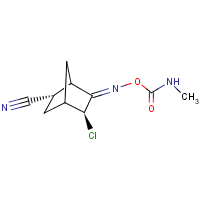Tranid
Agent Name
Tranid
CAS Number
15271-41-7
Formula
C10-H12-Cl-N3-O2
Major Category
Pesticides

Synonyms
5-Chloro-6-((((methylamino)carbonyl)oxy)imino)bicyclo(2.2.1)heptane-2-carbonitrile; 5-Chloro-6-((((methylamino)carbonyl)oxy)imino)bicyclo(2.2.1)heptane-2-carbonitrile (1S-(1alpha,2beta,4alpha,5alpha,6E))-; Bicyclo(2.2.1)heptane-2-carbonitrile, 5-chloro-6-((((methylamino)carbonyl)oxy)imino)-, (1S-(1alpha,2beta,4alpha,5alpha,6E))-; UC 2047A; UC-20047; exo-3-Chloro-endo-6-cyanobicyclo(2.2.1)heptan-2-one syn-(N-methylcarbamyl)oxime; exo-5-Chloro-6-oxo-endo-2-norbornanecarbonitrile syn-O-(methylcarbamoyl)oxime; syn-exo-3-Chloro-endo-6-cyano-2-norbornanone O-(methylcarbamoyl)oxime; trans-5-exo-Chloro-6-oxo-2-endo-norbornanecarbonitrile O-(methylcarbamoyl)oxime; 2-Norbornanecarbonitrile, 5-chloro-6-oxo-, O-(methylcarbamoyl)oxime, (E)-endo-2,exo-5-; [ChemIDplus]
Category
Carbamate Insecticides
Description
Solid; [CAMEO]
Sources/Uses
Used as insecticide and miticide; [HSDB] Used as experimental insecticide for mobile spider mites; [CAMEO]
Comments
A cholinesterase inhibitor; [CAMEO] No reproductive effects in mice that were fed 5 ppm in diet for 30 days before and after mating; [HSDB] See "CARBAMATE INSECTICIDES."
Restricted
Not registered with the EPA for use as pesticide in the US; [CAMEO]
Biomedical References
Exposure Assessment
BEI
Acetylcholinesterase activity in red blood cells = 70% of individual's baseline; Butylcholinesterase activity in serum or plasma = 60% of individual's baseline; Sample at end of shift; [TLVs and BEIs]
Adverse Effects
Other Poison
Carbamate
Diseases, Processes, and Activities Linked to This Agent
Diseases
Occupational diseases associated with exposure to this agent:
Processes
Industrial Processes with risk of exposure: